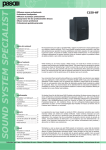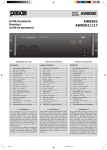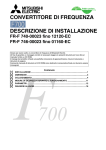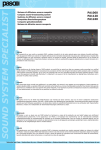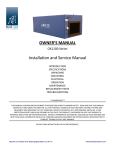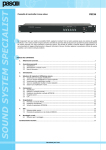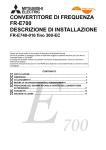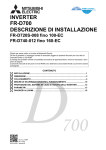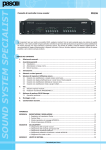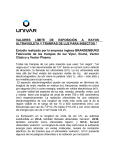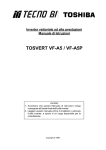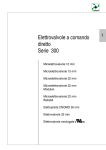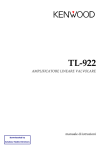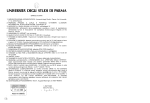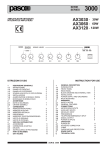Download M - PASO Sound Systems Products
Transcript
SOUND SYSTEM SPECIALIST α DATASHEET AWF120-HV AWF240-HV Amplificatori con isolamento a 4 KV Amplifiers with 4 KV insulation β INDICE DEI CONTENUTI TABLE OF CONTENTS 1. Descrizione generale .............................................. 3 1.1 Riferimenti numerati ........................................... 3 1. General description ................................................ 3 1.1 Numbered references .......................................... 3 2. Avvertenze .............................................................. 4 2.1 Informazioni generali .......................................... 4 2.2 Alimentazione e messa a terra ............................. 4 2.3 Note di sicurezza................................................. 4 2. Warnings................................................................. 4 2.1 General information ............................................ 4 2.2 Power supply and earthing .................................. 4 2.3 Safety notes ....................................................... 4 3. Esempio d’installazione ......................................... 5 3. Example of installation .......................................... 5 4. Connessioni ............................................................ 5 4.1 Criteri generali .................................................... 5 4.2 Ingresso/uscita di linea........................................ 5 4.3 Uscite di potenza ............................................... 6 • Sistemi a tensione costante ............................... 6 4.4 Accessori interni.................................................. 6 4.5 Scheda di controllo.............................................. 7 4.5.1 Connessioni .............................................. 7 • Collegamento alla linea altoparlanti ................... 7 • Collegamento ingressi (opzionale)...................... 7 • Collegamento del relè ....................................... 7 • Funzionamento del relè test .............................. 8 • Impostazione della modalità di funzionamento del relè test .............................. 8 • Collegamento a potenziometro remoto ............... 8 • Connettore ‘REMOTE CONTROL’ ........................ 8 4.5.2 Modalità di funzionamento ......................... 8 A) Modalità ‘STAND ALONE’ ................................. 9 B) Modalità ‘REMOTE CONTROL’ ........................ 13 4.5.3 Calibrazione............................................. 13 4. Connections ............................................................ 5 4.1 General criteria ................................................... 5 4.2 Line input/output ................................................ 5 4.3 Power outputs ................................................... 6 • Constant-voltage systems ................................. 6 4.4 Internal accessories ............................................ 6 4.5 Control card ....................................................... 7 4.5.1 Connections .............................................. 7 • Connecting to the loudspeakers line................... 7 • Connecting the inputs (optional) ........................ 7 • Connecting the relay ......................................... 7 • Operation of the test relay ................................ 8 • Setting the test relay operation mode ................................................ 8 • Connection to the remote potentiometer ............ 8 • ‘REMOTE CONTROL’ Connector ......................... 8 4.5.2 Operating modes ....................................... 8 A) ‘STAND ALONE’ Mode ..................................... 9 B) ‘REMOTE CONTROL’ Mode ............................. 13 4.5.3 Calibration............................................... 13 5. Uso dell’apparecchio ............................................ 14 5.1 Accensione ....................................................... 14 5.2 Display a led ..................................................... 14 5. Using the equipment ............................................ 14 5.1 Switching on ..................................................... 14 5.2 LED Display ...................................................... 14 6. Note di servizio..................................................... 14 6.1 Ventilazione forzata ........................................... 14 6.2 Condizioni di sovraccarico e protezione ............... 14 6.3 Tarature ........................................................... 14 6. Service notes ........................................................ 14 6.1 Forced ventilation ............................................. 14 6.2 Overload conditions and protection devices......... 14 6.3 Adjustments ..................................................... 14 Caratteristiche tecniche ............................................... 15 Technical specifications ............................................... 15 Criteri di dimensionamento ......................................... 16 Dimensioning criteria ................................................... 16 Tavole di configurazione .............................................. 17 Configuration tables ..................................................... 17 Istruzioni per l’uso • Instructions for use α DATASHEET Nel ringraziarVi per aver scelto un prodotto PASO, vogliamo ricordarVi che la nostra azienda opera con sistema di qualità certificato. Tutti i nostri prodotti vengono pertanto controllati in ogni fase della produzione per garantirVi la piena soddisfazione del Vostro acquisto. Per ogni evenienza la garanzia coprirà, nel periodo di validità, eventuali difetti di fabbricazione. Vi raccomandiamo di leggere attentamente le seguenti istruzioni d’uso per sfruttare appieno le prestazioni offerte da questo prodotto e per evitare eventuali problemi. While thanking you for having chosen a PASO product, we would like to remind you that our company works according to a certified Quality System. This means that all our products are checked during every phase of manufacturing in order to ensure that you will be fully satisfied with your purchase. In any case, the guarantee will cover any manufacturing flaws during the guarantee period. We recommend that you read the following instructions for use and follow them carefully in order to exploit in full the performance of this product and use it correctly. GARANZIA Questo prodotto è garantito esente da difetti nelle sue materie prime e nel suo montaggio; il periodo di garanzia è regolamentato dalle norme vigenti. La Paso riparerà gratuitamente il prodotto difettoso qui garantito se il difetto risulterà essersi verificato durante l’uso normale; la garanzia non si estende quindi a prodotti usati ed installati in modo errato, danneggiati meccanicamente, danneggiati da liquidi o da agenti atmosferici. Il prodotto, risultato difettoso, dovrà essere inviato alla Paso franco di spese di spedizione e ritorno. Questa garanzia non ne comprende altre, esplicite od implicite, e non comprende danni o incidenti conseguenti a persone o cose. Contattare i distributori PASO della zona per maggiori informazioni sulla garanzia. WARRANTY This product is warranted to be free from defects in raw materials and assembly. The warranty period is governed by the applicable provisions of law. Paso will repair the product covered by this warranty free of charge if it is faulty, provided the defect has occurred during normal use. The warranty does not cover products that are improperly used or installed, mechanically damaged or damaged by liquids or the weather. If the product is found to be faulty, it must be sent to Paso free of charges for shipment and return. This warranty does not include any others, either explicit or implicit, and does not cover consequential damage to property or personal injury. For further information concerning the warranty contact your local PASO distributor. Importante! L’utente ha la responsabilità di produrre una prova d’acquisto (fattura o ricevuta) se vuole servirsi dell’assistenza coperta da garanzia. Dovrà inoltre fornire data di acquisto, modello e numero di serie riportati sull’apparecchio; a questo scopo, compilare come promemoria dei dati richiesti lo spazio qui sotto. Important! Should the user wish to avail himself of servicing under the warranty, he must provide evidence of the purchase (invoice or receipt). The user shall also indicate the date of purchase, model and serial number indicated on the equipment. For this reason, you should complete the box below as a reminder of the data required. MODELLO / MODEL: ............................................................................................................................................................................................. NUMERO DI SERIE / SERIAL NUMBER: .................................................................................................................................................................. DATA D’ACQUISTO / PURCHASE DATE: ................................................................................................................................................................. Questo prodotto è conforme alle Direttive della Comunità Europea sotto le quali lo stesso ricade. Tutti gli apparecchi PASO sono costruiti nel rispetto delle più severe normative internazionali di sicurezza ed in ottemperanza ai requisiti della Comunità Europea. Per un corretto ed efficace uso dell’apparecchio è importante prendere conoscenza di tutte le caratteristiche leggendo attentamente le presenti istruzioni ed in particolare le note di sicurezza. 2 This product is in keeping with the relevant European Community Directives. All PASO equipment is manufactured in accordance with the most stringent international safety standards and in compliance with European Community requisites. In order to use the equipment correctly and effectively, it is important to be aware of all its characteristics by reading these instructions and in particular the safety notes carefully. TEEHSATAD AWF120-HV, AWF240-HV 1. DESCRIZIONE GENERALE La peculiarità di questi amplificatori consiste nella capacità di sopportare la presenza di elevate tensioni tra alimentazione di rete/uscite altoparlanti e telaio, che possono arrivare fino ai 4 kV. Questa caratteristica aumenta la sicurezza dell’impianto, impedendo che un’eventuale scarica sulla rete o sulle connessioni altoparlanti possa risalire la catena audio e provocare quindi gravi danni a cose o persone. 1.1 (1) (2) (3) (4) (5) (6) (7) (8) (9) (10) (11) (12) (13) (14) Riferimenti numerati Spina di rete con fusibile incorporato. Feritoie d’aerazione superiori. Interruttore di rete. Morsettiera diffusori ed alimentazione esterna in c.c. Morsettiera Control I/O. Dip-switch. Regolatore volume d’uscita. Led di conferma acquisizione impostazioni. Spia di accensione. Display a led. Connettore per controllo remoto. Prese per ingresso/uscita di linea. Fusibile di protezione dell’alimentazione in c.c. Feritoie d’aerazione inferiori. Nota Prima di usare l’apparecchio, leggere attentamente le istruzioni contenute nel manuale cartaceo o su supporto cd, ponendo particolare attenzione alle note di sicurezza. ••• 1. GENERAL DESCRIPTION The peculiarity of these amplifiers consists of their ability to withstand the presence of high voltages, up to 4 kV, between the mains power/loudspeaker outputs and the frames. This feature increases the safety of the system as it prevents discharges on the line or on the loudspeaker line from moving up the audio chain and causing serious damage to property or personal harm. 1.1 (1) (2) (3) (4) (5) (6) (7) (8) (9) (10) (11) (12) (13) (14) Numbered references Mains plug with built-in fuse. Upper ventilation slits. Mains power switch. Terminal strip for loudspeakers and external power supply. Control I/O terminal strip. Dip-switch. Output volume controller. LED for acquisition settings confirmation. ON/OFF signalling lamp. LED display. Remote control connector. Line input/output sockets. Fuse for protecting the DC power supply. Lower ventilation slits. Note Before using the equipment, make yourself aware of all characteristics by reading carefully the instructions included in the printed manual or on the CD, paying particular attention to the safety notes. 3 α 4 DATASHEET 2. AVVERTENZE 2.1 Informazioni generali Tutti gli apparecchi PASO sono costruiti nel rispetto delle più severe normative internazionali di sicurezza ed in ottemperanza ai requisiti della Comunità Europea. Per un corretto ed efficace uso dell’apparecchio è importante prendere conoscenza di tutte le caratteristiche leggendo attentamente le presenti istruzioni ed in particolare le note di sicurezza. Durante il funzionamento dell’apparecchio è necessario assicurare un’adeguata ventilazione. Evitare di racchiudere l’apparecchio in un mobile privo di aerazione o di ostruirne le fessure di ventilazione. Evitare inoltre di tenere l’apparecchio in prossimità di sorgenti di calore (termosifoni, impianti di riscaldamento, ecc.). Prima dell’accensione assicurarsi che tutti gli ingressi e le uscite siano correttamente collegati. 2. WARNINGS 2.1 General information All PASO equipment is built according to the strictest international safety standards and complies with European Community requisites. In order to use the equipment correctly and effectively, it is important to be aware of all its features by reading these instructions and in particular the notes on safety carefully. While the equipment is working, it is necessary to ensure adequate ventilation. Avoid closing the equipment inside a cabinet without ventilation and take care not to obstruct the ventilation slits. Also avoid keeping the equipment near a source of heat (radiator, heating systems and so on). Before switching on the equipment, make sure that all the inputs and outputs are correctly connected. 2.2 Alimentazione e messa a terra L’apparecchio è predisposto per il funzionamento con tensione di rete a 230 V ± 10% 50/60 Hz. E’ prevista, in alternativa, la possibilità di alimentare l’apparecchio con una tensione continua esterna di 24V da applicare agli appositi morsetti ‘24V’ della morsettiera (4). I terminali della morsettiera accettano cavi con una sezione massima di 2,5 mm2; si tenga presente che, per brevi tratti (non superiori ai due metri), la sezione minima dei cavi di collegamento deve essere di 1,5 mm2. Tipicamente questa tensione proviene da accumulatori mantenuti sotto carica in tampone ed entra in funzione soltanto in caso di emergenza; è necessario, in questo caso, prevedere l’uso di un relè esterno che connetta le batterie all’apparecchio solo quando viene a mancare l’alimentazione di rete. L’apparecchio è protetto contro le inversioni di polarità. In accordo con le normative di sicurezza, l’interruttore di accensione (3) agisce solo sulla tensione di rete. 2.2 Power supply and earthing The equipment has provisions for operation with a mains voltage of 230 V ± 10% 50/60 Hz. As an alternative, it is possible to power the equipment with an external continuous voltage of 24V to be applied to the appropriate ‘24V’ terminal on the terminal strip (4). The terminals on the terminal strip take cables with a maximum cross-section of 2.5 mm2. Note, however, that for short stretches (not exceeding two metres), the cross-section of the connecting cables must be at least 1.5 mm2. Typically, this voltage is taken from accumulators under float charged that only starts working in case of emergencies. In this case, it is necessary to envisage use of an external relay for connecting the batteries to the equipment only when the mains power supply fails. The equipment is protected against polarity inversions. In accordance with the safety regulations, the ON/OFF switch (4) is only effective for the mains power supply. 2.3 Note di sicurezza Ogni intervento all’interno dell’apparecchio, quale la selezione di alcuni modi d’uso o l’applicazione di accessori, deve essere effettuato solo da personale specializzato: la rimozione del coperchio rende accessibili parti con rischio di scosse elettriche. Prima di rimuovere i pannelli di chiusura, accertarsi sempre che il cavo di rete sia staccato. Nel caso di accidentale caduta di liquidi sull’apparecchio, staccare immediatamente la spina di rete ed interpellare il centro di assistenza PASO più vicino. L’apparecchio é corredato di cavo di alimentazione con filo di terra ed il relativo terminale sulla spina di rete non deve essere rimosso in alcun caso. Assicurarsi che la presa di corrente sia dotata di collegamento di terra a norma di legge. La connessione di massa telaio della morsettiera (4) consente di collegare altre apparecchiature per la sola funzione di schermatura dei segnali a basso livello: questa presa non deve essere utilizzata per il collegamento di sicurezza del telaio alla terra. 2.3 Safety notes Any work inside the equipment, such as selecting some of the modes of operation or applying accessories may only be carried out by specialised personnel. On removing the cover, parts entailing a danger of electric shocks will be made accessible. Always make sure that the mains cable of the power-supply module is disconnected before removing the panels. If any liquid is accidentally spilt on the equipment, disconnect the mains cable immediately and contact the nearest PASO Service Centre. The equipment is supplied with its own power-supply cable with an earth wire. The relevant terminal on the mains plug must never be removed, under any circumstances. Make sure that the power outlet has a connection to earth in accordance with the law. The frame ground connection (4) can be used to connect other equipment for the sole purpose of shielding low-level signals. This socket must never be used for the safety connection of the frame to earth. IMPORTANTE! IMPORTANT! sono attivi e pericolosi. I terminali marcati con il simbolo Il cablaggio esterno collegato a questi terminali, DEVE essere eseguito esclusivamente da personale specializzato. are active and The terminals marked with the symbol dangerous. The external connections toward these terminals MUST be carried out by specialized personnel only. Nota PASO S.p.A declina ogni responsabilità per danni a cose e/o persone derivanti dall’uso non corretto dell’apparecchio o da procedure non rispondenti a quanto riportato sul presente libretto. Nel continuo intento di migliorare i propri prodotti, la PASO S.p.A. si riserva il diritto di apportare modifiche ai disegni e alle caratteristiche tecniche in qualsiasi momento e senza alcun preavviso. Note PASO S.p.A will not accept any liability for damage to property and/or persons arising out of incorrect use of the equipment or of procedures that do not comply with the instructions provided in this booklet. PASO S.p.A. strive to improve their products continuously, and therefore reserve the right to make changes to the drawings and technical specifications at any time and without notice. TEEHSATAD 3. ESEMPIO D’INSTALLAZIONE L’amplificatore può essere montato e fissato a parete in maniera molto semplice utilizzando l’apposita piastra fornita in dotazione. Per procedere con il fissaggio, operare come segue: 1. Utilizzare la piastra (A) come dima e prendere nota della posizione dei fori (B); 2. Forare la parete e posizionare la piastra fissandola con fischer, viti e rondelle - non inclusi - a seconda delle specifiche esigenze; 3. Inserire l’amplificatore sulla piastra facendo coincidere i perni (C) con le asole presenti sul pannello posteriore e farlo scorrere verso il basso; fissare quindi l’amplificatore alla piastra tramite il galletto (D). AWF120-HV, AWF240-HV 3. EXAMPLE OF INSTALLATION The amplifier can be mounted and fixed to the wall in a very simple using the supplied plate. To proceed with the mounting, follow these steps: 1. Use the plate (A) as template, and note the position of the holes (B); 2. Pierce the wall and place the plate securing it by fishers, screws and washers - not included - depending on your specific needs; 3. Insert the amplifier on the plate by the pins (C) with the slots on the rear panel and slide down, then set the amp to the plate through the wing nut (D). B C A Fig. 3.1.1 Fig. 3.1.2 Fig. 3.1.3 4. CONNESSIONI 4.1 Criteri generali Per un corretto funzionamento dell’apparecchio è opportuno osservare alcuni criteri di massima nell’esecuzione dei collegamenti: • evitare il posizionamento di cavi e di microfoni sul mobile dell’apparecchio. • evitare di stendere le linee di segnale parallele a quelle di rete; osservare una distanza minima di 30/40 cm. • posizionare le linee di ingresso e le linee di uscita distanti tra loro. • posizionare i microfoni al di fuori dell’angolo di radiazione dei diffusori sonori per evitare il fenomeno di reazione acustica (effetto Larsen). 4. CONNECTIONS 4.1 General criteria In order to allow the equipment to work correctly, it is advisable to comply with a number of general criteria when making the connections: • Avoid positioning cables or microphones on the cabinet of the equipment. • Avoid laying the signal lines parallel to the power-supply lines. Keep a minimum distance of 30/40 cm. • Position the input and the output lines at a distance from one another. • In order to avoid acoustic feedback (the Larsen effect), position the microphones out of the angle of coverage of the loudspeakers. 4.2 Ingresso/uscita di linea Sul pannello frontale dell’apparecchio sono disponibili le prese XLR d’ingresso/uscita (12) per segnali a livello linea (0 dB, 775 mV) dell’unità di potenza; le prese sono parallelate per agevolare il collegamento in cascata di più unità di potenza. In fig. 4.2.1 sono riportate le connessioni a queste prese. L’ingresso dell’amplificatore è bilanciato elettronicamente; per particolari esigenze come, ad esempio, nel caso di lunghi cavi di collegamento e/o forti campi elettromagnetici disturbanti, è possibile isolare galvanicamente l’ingresso dell’amplificatore tramite la scheda opzionale TM92, dotata di traslatore di linea (vedi paragrafo 4.4). 4.2 Line input/output The XLR input/output sockets (12) for the line-level signals (0 dB, 775 mV) of the power unit are located on the front panel of the equipment. The sockets are paralleled in order to facilitate cascade connection of several power units. Figure 4.2.1 shows the connections to these sockets. The input of the amplifier is electronically balanced. For special requirements such as, for example, in case of long connecting cables and/or strong electromagnetic fields that cause interference, it is possible to insulate the amplifier input galvanically using the optional TM92 card, equipped with a line transformer (see paragraph 4.4). IN/OUT IN/OUT 1 = Schermo - Shield 2 = Segnale (lato caldo) - Signal (warm side) 3 = Segnale (lato freddo) - Signal (cold side) XLR-F XLR-M Fig. 4.2.1 5 α DATASHEET 4.3 Uscite di potenza Le uscite di potenza per i diffusori sono disponibili sulla morsettiera (4) per impianti di distribuzione a tensione costante (50, 70 e 100 V) e per connessioni a bassa impedenza (4/8 Ω). In tabella 4.3.1 sono riportati i valori nominali di tensione ed impedenza per le diverse uscite. 4.3 Power outputs The power outputs for the speaker units are available on the terminal strip (4) for constant-voltage distribution systems (50, 70 and 100 V) and for low-impedance connections (4/8 Ω). Table 4.3.1 shows voltage and impedance rated values for the various outputs. Uscita / Output AWF120-HV AWF240-HV 50 V 20,8 Ω 10,4 Ω 70 V 40,8 Ω 20,4 Ω 100 V 83,3 Ω 41,7 Ω Tab. 4.3.1 • Sistemi a tensione costante Nel caso di impianti con un gran numero di diffusori e/o con distanze tra amplificatori ed altoparlanti molto elevate é preferibile utilizzare un sistema di distribuzione a tensione costante (definito anche ad alta impedenza). In questo tipo di impianto, i diffusori, provvisti di trasformatori di adattamento d’impedenza, sono tutti collegati in derivazione alla linea (vedi Fig. 4.3.2). • Constant-voltage systems For systems including a large number of loudspeakers and/or with large distances between the amplifiers and the loudspeakers, it is preferable to use a constant-voltage distribution system (also known as highimpedance systems). In this type of system the loudspeakers, which are equipped with impedance-matching transformers, are all connected by branching them from the line (see example in Figure 4.3.2). Fig. 4.3.2 Questo particolare rende di facile realizzazione l’impianto e, nel caso in cui un altoparlante dovesse per qualche motivo scollegarsi dalla linea, il resto dell’impianto proseguirebbe nel suo regolare funzionamento. Le tensioni costanti disponibili in uscita dall’amplificatore sono da 50, 70 e 100 V. Per il corretto dimensionamento dell’impianto (scelta della tensione di linea dell’apparecchio e selezione della potenza del diffusore) é possibile individuare diverse procedure, riportate con esempi numerici nella sezione ‘Criteri di dimensionamento’ (pag. 16). This fact makes the system easy to create and, if any of the loudspeakers should be disconnected from the line for any reason, the rest of the system would continue to function properly. The constant voltages available as outputs from the amplifier are 50, 70 and 100 V. There are several possible procedures for sizing the system correctly (by choosing the line voltage of the equipment or by choosing the output power of the loudspeaker). Numerical examples of these procedures are provided at section ‘Dimensioning criteria’ (page 16). 4.4 Accessori interni 4.4 Internal accessories Queste operazioni richiedono la rimozione del pannello laterale destro e rendono pertanto accessibili parti con rischio di scosse elettriche: devono essere quindi affidate SOLO a personale tecnico qualificato. These operations require the removal of the right side panel and make it accessible parts with risk of electric shock: they must be entrusted ONLY by qualified personnel. Internamente all’amplificatore è possibile installare l’accessorio TM92 (scheda traslatore di linea). Una volta rimosso il pannello laterale destro dell’amplificatore, identificare il connettore CN101 (fig. 4.4.1); rimuovere i ponticelli cortocircuitanti in esso inseriti e posizionare al loro posto la scheda TM92. Richiudere l’apparecchio riposizionando il pannello precedentemente rimosso. The accessory TM92 (line translator card) can be installed inside the amplifier. Once removed the side panel, identify connector CN101 (fig. 4.4.1), remove the jumpers inserted into it and put in place the card TM92. Replace the unit repositioning the panel previously removed. Fig. 4.4.1 6 TEEHSATAD AWF120-HV, AWF240-HV 4.5 Scheda di controllo Gli amplificatori sono equipaggiati con la scheda di controllo PM2092/2-V, in grado di offrire un’elevato numero di funzioni aggiuntive. 4.5 Control card The amplifiers are equipped with PM2092/2-V control card, which is able to provide a range of additional functions. NOTA: per motivi di sicurezza, sulla scheda PM2092/2-V risulta disattivato il controllo del test GROUND FAULT. NOTE : for safety reasons, the check of the GROUND FAULT TEST will be de-activated on the PM2092/2-V. Questa gestisce tutte le funzioni dell’amplificatore, dagli ingressi alla diagnostica ed è in grado di eseguire le seguenti funzioni: • misure di impedenza di linea; • diagnostica dell’amplificatore; • verifica dell’integrità della linea altoparlanti (PM2094-V). • verifica isolamento di terra (GND FAULT); • controllo di volume; • selezione di due ingressi; • controllo relè segnalazione guasti; • possibilità di inserimento del filtro LOW CUT; • funzionamento in modalità di risparmio energetico ‘LOW POWER’. La scheda può inoltre essere controllata tramite interfaccia seriale. Oltre ad eseguire tutte le operazioni e/o verifiche impostate localmente con i dipswitches, sarà possibile visualizzare e modificare tutti i parametri tra cui: • lettura dell’impedenza di riferimento per il test; • valore minimo e massimo entro cui il test risulta valido; • lettura dello stato dei test; • test dell’ingresso; • misura della temperatura dei transistor finali; • regolazione del volume; • comando remoto del relè test. This card manages all the functions of the amplifier, from the inputs to diagnostics, and is capable of carrying out the following functions: • line impedance measurements; • amplifier diagnostics; • check of the integrity of the loudspeaker line (PM2094-V). • check of insulation to earth (GND FAULT); • volume control; • selection of two inputs; • checking of fault-reporting relay; • possibility of including the LOW CUT filter; • operation in the ‘LOW POWER’ energy-saving mode. The card can also be controlled via a serial interface. In addition to carrying out all the operations and/or checks set locally by means of the dip switches, it will also be possible to display and alter all the parameters, including the following: • reading of the reference impedance for the test; • minimum and maximum values between which the test is valid; • reading of the test status; • testing of the input; • measurement of the temperature of the end transistors; • volume adjustment; • remote control of test relay. 4.5.1 Connessioni La morsettiera ‘CONTROL I/O’ (5) presente sul pannello frontale dell’amplificatore permette di utilizzare, se necessario, il relè, il secondo ingresso bilanciato ed un eventuale controllo remoto del volume. • Collegamento alla linea altoparlanti Il collegamento agli altoparlanti viene illustrato nella figura 4.5.1 4.5.1 Connections The ‘CONTROL I/O’ terminal strip (5) on the front panel of the amplifier can be used, if necessary, to active the relay, the second balanced input and the volume control. • Connecting the loudspeakers line The connection to the loudspeakers line is shown in fig. 4.5.1. Fig. 4.5.1 • Collegamento ingressi (opzionale) Qualora si volesse collegare un secondo ingresso, utilizzare i terminali 8, 9 e 10 della morsettiera ‘CONTROL I/O’ (5) (vedi fig. 4.5.2). • Connecting the inputs (optional) If you wish to connect a second input, use terminals 8, 9 and 10 of the ‘CONTROL I/O’ terminal strip (5), as shown in Figure 4.5.2. Fig. 4.5.2 Fig. 4.5.3 • Collegamento del relè Come riportato sul pannello dell’amplificatore, i collegamenti del relè sono quelli illustrati in fig. 4.5.3. • Connecting the relay As shown on the top panel of the amplifier, the connections for the relay are those illustrated in Figure 4.5.3. 7 α DATASHEET • Funzionamento del relè test Le modalità di funzionamento del relè test sono tre. La prima (MODE 0 - impostazione di fabbrica) prevede che il relè test sia sempre eccitato e si disecciti solo per mancanza di alimentazione o guasto all’amplificatore. In questa modalità è possibile, tramite l’utilizzo della scheda PM2095, impostare un sistema di più amplificatori con l’inserzione automatica di una o più riserve. La seconda modalità (MODE 1), il relè test è sempre eccitato e si diseccita solo in presenza di un guasto sulla linea degli altoparlanti. Nella terza modalità (MODE 2), il relè test è sempre eccitato e si diseccita se vi è un guasto di linea o dell’amplificatore. • Operation of the test relay There are three operation modes of the test relay. In the first mode (MODE 0 – factory setting), the test relay is always energized and is de-energised only in the absence of power or in case of failure of the amplifier. It this mode it is possible to use the PM2095 card to set up a system of several amplifiers with automatic inclusion of one or more standby units. In the second mode (MODE 1), the test relay is always energized and is de-energized only if there is a failure on the loudspeaker line. In the third mode (MODE 2), the test relay is always energized and is de-energized if there is a line or amplifier failure. • Impostazione della modalità di funzionamento del relè test Viene di seguito illustrata la sequenza da effettuare per impostare le diverse modalità tramite il dip-switch della scheda. Le leve vanno abbassate in modo sequenziale (non simultaneo). • Setting the test relay operating mode The sequence to be carried out to set the various modes by means of the dip switch on the card is illustrated below. The levers must be lowered in sequence (not simultaneously). • Collegamento a potenziometro remoto Il potenziometro per il controllo a distanza del volume deve essere collegato ai terminali 6, 7 e 8 della morsettiera ‘CONTROL I/O’. Fare riferimento alla fig. 4.5.5 per incrementare o decrementare il volume. 7 7 7 6 6 6 Guasto linea Line failure 5 5 4 4 3 1 2 ON 3 1 2 ON 3 3 1 2 ON 3 1 2 ON 4 3 1 2 ON 4 3 1 2 ON 4 3 1 2 ON 4 3 1 2 ON 4 4 5 5 5 5 5 5 6 6 6 6 6 6 5 4 3 1 2 ON Guasto amplificatore Amplifier failure D 7 7 7 7 7 7 7 6 5 4 3 1 2 ON MODE 1 C 8 8 8 8 8 8 8 8 7 6 5 4 3 1 2 ON MODE 0 B 8 A 8 D 1 2 ON C 8 B 7 A 6 D 5 C 4 B 8 A Fig. 4.5.4 MODE 2 Guasto amplificatore o linea Amplifier or line failure • Connection to the remote potentiometer The potentiometer for remote volume control must be connected to terminals 6, 7 and 8 of the ‘CONTROL I/O’ terminal strip. Refer to Figure 4.5.5 for raising or lowering the volume. 10 kΩ Potenziometro lineare Linear potentiometer Fig. 4.5.5 • Connettore ‘REMOTE CONTROL’ Questo connettore deve essere utilizzato per il collegamento dell’amplificatore ad un PC o ad un sistema PMS2000/PMS2006-VES. Una volta effettuata questa connessione, sarà possibile controllare tramite software dedicato la scheda PM2092/2-V. Nella tabella sottostante è riportata la piedinatura del connettore. REMOTE CONTROL Pin • ‘REMOTE CONTROL’ Connector This connector must be used to connect the amplifier to a PC or to a PMS2000/PMS2006-VES system. Once this connection has been made, it will then be possible to control the PM2092/2-V card by means of dedicated software. The following table shows the pinout of the connector. Descrizione Description 1 Alimentazione esterna 24V (opzionale) 24V External power supply (optional) 2 Alimentazione esterna 24V (opzionale) 24V External power supply (optional) 3 Massa GND 4 Selezione ingressi Inputs selection 5 RS485 + RS485 + 6 Alimentazione esterna 24V (opzionale) 24V External power supply (optional) 7 Massa GND 8 Massa GND 9 RS485 – RS485 – Tab. 4.5.6 4.5.2 Modalità di funzionamento Le modalità di funzionamento consentite dalla scheda sono due: • Modalità ‘Stand-alone’; • Modalità ‘Controllo remoto’ Nei paragrafi seguenti verranno illustrate tutte le impostazioni e le modifiche che possono essere applicate alla scheda in entrambe le modalità d’uso. 8 4.5.2 Operating modes There are two possible operating modes enabled by the card: • ‘Stand-alone’ Mode; • ‘Remote control’ Mode The settings and the changes that can be applied to the card in each of the operating modes are described in the following paragraphs. AWF120-HV, AWF240-HV TEEHSATAD A) Modalità ‘STAND ALONE’ In questa modalità, è necessario impostare alcuni parametri tramite l’apposito dip-switch ‘MODE SEL.’ (6) presente sul posteriore dell’amplificatore. La levetta 1 del dip-switch svolge la funzione di ‘Invio’: deve essere cioè utilizzata per dare conferma delle scelte effettuate con le altre leve. A) ‘STAND ALONE’ Mode In this mode, it is necessary to set some parameters using the ‘MODE SEL.’ (6) dip-switch provided for this purpose on the rear of the amplifier. Lever 1 of the dip-switch has an ‘Enter’ function. That is to say, it has to be used to confirm the choices opted for with the other levers. • Acquisizione dell’impedenza della linea altoparlanti Una volta installate in modo definitivo le linee di altoparlanti e collegato l’amplificatore come indicato nel capitolo ‘Connessioni’, è necessario che l’amplificatore acquisisca l’impedenza corrente. Tale impedenza verrà presa come riferimento per le misurazioni future. • Loudspeakers line impedance acquisition Once the loudspeakers lines has been permanently installed, and the amplifier has been connected as indicated in the chapter on ‘Connections’, it is necessary for the amplifier to acquire the current impedance. This impedance value will be used as a reference for the future measurements. If the results of the measurements exceed the reference value by ±30%, the amplifier will signal the problem that has been detected by means of the LED. To acquire the reference impedance value, proceed as follows: 8 8 8 6 5 4 3 1 2 ON 6 5 3 1 2 ON 4 3. Return levers 1 and 8 to the OFF position: the red LED will extinguish. Fig. 4.5.7 • Setting the interval between one test and the next Levers 4 to 8 have to be used for setting the required testing interval. Lever 2 identifies the ‘test time’ mode. For example, to set an interval of 5 seconds: 1. Move lever 2 to the ON position; 2. Move lever 1 to the ON position (Enter): the red ‘OK’ LED will light up steadily. 3. Return lever 1 and then lever 2 to the OFF position. The LED will extinguish to show that the setting has been correctly acquired. Figure 4.5.8 shows examples referred to setting the most commonly used intervals. 0 = 5 sec. (intervallo minimo/minimum interval) 1 = 1 min 8 7 6 5 4 3 1 2 ON 8 7 6 5 4 3 1 2 ON 8 7 6 3 4 5 6 7 8 D 1 2 ON 8 7 6 5 4 3 1 2 ON 8 7 6 5 4 3 1 2 ON 3 1 2 ON C 31 = NO TEST 5 6 7 8 D 3 3 3 3 3 3 3 1 2 ON 1 2 ON 1 2 ON 1 2 ON 1 2 ON 1 2 ON 4 5 6 7 8 C 4 5 6 7 8 B 4 5 6 7 8 A 4 5 6 7 8 D 4 8 7 6 5 B 1 2 ON 4 8 7 6 5 D 3 4 8 7 6 5 C C 1 2 ON 4 B 5 8 7 6 5 4 3 8 7 6 5 3 1 2 ON 4 8 7 6 5 3 4 A 2 = 2 min A B 30 = 1 h (intervallo massimo/maximum interval) D 1 2 ON 4 5 6 7 8 C 3 4 5 6 7 8 B 1 2 ON 1 2 ON 3 4 5 6 7 8 A 29 = 29 min A 1 2 ON 3 4 5 6 7 8 D 1 2 ON 3 4 5 6 7 8 C 1 2 ON 3 4 5 6 7 8 B 1 2 ON 1 2 ON 3 4 5 6 7 8 A 4 • Impostazione dell’intervallo tra un test ed il successivo Per impostare l’intervallo di test desiderato, devono essere utilizzate le levette da 4 a 8. La levetta 2 identifica il modo ‘test time’. Impostiamo ad esempio un intervallo di 5 secondi: 1. Portare la levetta 2 in posizione ON; 2. Portare in posizione ON la levetta 1 (Invio): il led rosso ‘OK’ si accende in modo fisso. 3. Riportare in posizione OFF la leva 1 e successivamente la leva 2; il led si spegne indicando che l’impostazione è stata acquisita correttamente. Riportiamo nella figura 4.5.8 gli esempi della impostazione degli intervalli più comuni. 3 6 5 3 1 2 ON 4 6 5 4 3 1 2 ON 3. Riportare la leva 1 e la leva 8 in posizione OFF: il led rosso si spegne. 1. Switch on the amplifier. 2. Operate the dip switch by moving lever 8 to the ON position and then lever 1 as shown in Figure 4.5.7. After about 2 seconds the red ‘OK’ LED will remain steadily on to indicate correct acquisition of the line impedance. 7 D 7 C 7 B 7 1. Accendere l’amplificatore. 2. Operare sul dip-switch portando in posizione ON la levetta 8 e successivamente la levetta 1 come indicato in figura 4.5.7. Il led rosso ‘OK’ dopo circa 2 secondi rimarrà acceso in modo fisso ad indicare la corretta acquisizione dell’impedenza di linea. A 8 Acquisizione impedenza linea altoparlanti Loudspeakers line impedance acquisition 1 2 ON Qualora le misure superino il ±30% della misura di riferimento, l’amplificatore segnalerà tramite led l’anomalia rilevata. Per acquisire l’impedenza di riferimento, procedere nel seguente modo: Per gli altri valori, consultare le ‘Tavole di configurazione’ a pag. 17. Una volta scelto l’intervallo desiderato, l’amplificatore ripeterà periodicamente il test. Questo consentirà di monitorare il funzionamento dell’amplificatore e di verificare in tempo reale la presenza di guasti o anomalie della linea. Fig. 4.5.8 For the other values, consult the ‘Configuration Tables’ on page 17. Once the required interval has been chosen, the amplifier will repeat the test periodically. This will make it possible to monitor operation of the amplifier and to check the presence of any failures or upsets in the line in real time. 9 α LED DATASHEET CONDIZIONI DI GUASTO FAILURE CONDITIONS Il led lampeggia (50%) The LED is flashing (50%) Durante il test è stato rilevato un valore d’impedenza inferiore During the test, an impedance value 30% lower than the one del 30% di quello acquisito durante l’installazione. acquired during installation one is detected. SPK Il led emette tre brevi flash ogni 3” É stato rilevato un cortocircuito sulla linea altoparlanti. The LED flashes three times every 3” A short-circuit on the loudspeakers line is detected. Il led è acceso (fisso) The LED is ON (steady) Durante il test è stato rilevato un valore d’impedenza superiore During the test, an impedance value 30% higher than the one del 30% di quello acquisito durante l’installazione. acquired during installation one is detected. AMP Il led si accende Indica un guasto dell’amplificatore. The LED lights up This indicates a failure of the amplifier. Tab. 4.5.9 Si tenga in ogni caso presente che in assenza di guasti, i led sul pannello frontale dell’amplificatore fungono da VU-METER. It must in any case be kept in mind that in the absence of failures, the LED’s on the front panel of the amplifier act as VU-METERs. Qualora vi sia almeno un guasto, la funzione VU-METER viene abbandonata e i led indicheranno il guasto rilevato. If there is at least one failure, the VU-METER function is quit, and the LED’s will indicate the failure that has been detected. • Controllo di volume É possibile scegliere tra quattro diverse modalità di regolazione, impostabili tramite appositi jumper da posizionare nei connettori evidenziati in figura. • Volume control It is possible to choose from among four different adjustment modes that can be set by means of jumpers to be positioned in the connectors shown in the figure. CN8/CN11 Selezione mod. controllo volume Volume control mode selection Fig. 4.5.10 Nella pagina seguente vengono illustrate e descritte le quattro combinazioni di jumper ed il conseguente funzionamento della scheda. 10 The four combinations of jumpers are shown and described on the following page, illustrating operation of the card in each case. AWF120-HV, AWF240-HV TEEHSATAD Jumper Funzionamento / Operation (1) MIX MIX NO YES Le sorgenti di regolazione del volume (trimmer su scheda o trimmer collegato a morsettiera o regolazione volume da seriale) regolano simultaneamente il volume di entrambi gli ingressi. La presenza di un segnale audio sull’ingresso XLR ammutolisce il segnale proveniente dalla morsettiera con un tempo di retrigger di circa 4 secondi. VOL The volume control sources (trimmer on the card or trimmer connected to the terminal strip or volume control from a serial connection) adjust the volume of both inputs simultaneously. The presence of an audio signal on the XLR input mutes the signal from the terminal strip with a retrigger time of about 4 seconds. 1 2 (2) MIX MIX NO YES 2 The trimmer on the card adjusts the volume of the terminal strip input and the trimmer connected to the terminal strip also adjusts the volume of the terminal strip input. The two adjustments are cumulative. If the trimmer connected to the terminal strip is disconnected, the attenuation of this trimmer is cancelled out. The volume of the XLR input is always at its maximum and it can only be adjusted via a serial connection. The presence of an audio signal on the XLR input mutes the signal from the terminal strip with a retrigger time of about 4 seconds. MIX MIX NO YES La sorgente di regolazione del volume (trimmer su scheda o trimmer collegato a morsettiera o regolazione volume da seriale) regola il volume del canale selezionato (ingresso XLR o ingresso morsettiera). La selezione dell’ingresso morsettiera (strip) effettuata collegando a massa tramite interruttore il pin 4 della presa DB9 ha ptiorità sulla selezione dell’ingresso effettuata dalla seriale. 1 (3) Il trimmer su scheda regola il volume dell’ingresso morsettiera, il trimmer collegato alla morsettiera regola anch’esso il volume dell’ingresso morsettiera; le due regolazioni si sommano. Se il trimmer connesso alla morsettiera viene scollegato, l’attenuazione che lo riguarda si annulla. Il volume dell’ingresso XLR è sempre al massimo ed è possibile regolarlo solo da collegamento seriale. La presenza di un segnale audio sull’ingresso XLR ammutolisce il segnale proveniente dalla morsettiera con un tempo di retrigger di circa 4 secondi. 1 VOL VOL 2 MIX MIX NO YES (4) 1 VOL The volume control source (trimmer on the card or trimmer connected to the terminal strip or volume control from serial connection) adjusts the volume of the channel that is selected (XLR input or terminal strip input). The terminal strip input (strip) selected by connecting pin 4 of socket DB9 to earth has priority over selection of the input via the serial connection. Vedi punto 3. See point 3. 2 Tab. 4.5.11 • Selezionare la sorgente di regolazione del volume Alla prima accensione, la regolazione del volume di uscita viene affidata al trimmer posto a lato del led ‘OK’. É inoltre possibile controllare il volume dell’amplificatore con un potenziometro posto a distanza oppure tramite collegamento seriale. Per selezionare la sorgente della regolazione di volume, operare sulle levette del dip-switch come indicato nella figura 4.5.12. • Selecting the volume control source When the equipment is switched on for the first time, adjustment of the output volume is made by means of a trimmer situated next to the ‘OK’ LED. It is also possible to control the volume of the amplifier by means of a remote potentiometer or by means of a serial connection. To select the source of the volume control, position the levers of the dip switch as indicated in Figure 4.5.12. 8 7 6 5 3 3 3 1 2 ON 1 2 ON 4 8 7 6 5 D 1 2 ON 4 8 7 6 5 8 7 6 5 C 3 4 B 1 2 ON 1 2 ON 3 4 5 6 7 8 A Seriale • RS485 • Serial 3 3 1 2 ON 4 5 6 7 8 D 1 2 ON 4 5 6 7 8 C 3 4 5 6 7 8 B 1 2 ON 4 5 6 7 8 A 3 3 1 2 ON • On board trimmer • D 1 2 ON 3 1 2 ON 4 5 6 7 8 C 3 4 5 6 7 8 B 1 2 ON 4 5 6 7 8 A 4 Potenziometro remoto • Remote potentiometer Fig. 4.5.12 11 α DATASHEET • Selezione degli ingressi Il funzionamento degli ingressi può assumere due modalità: 1) ingressi in commutazione 2) ingressi in miscelazione L’impostazione di fabbrica prevede la miscelazione dei due ingressi (mod. 2); qualora siano entrambi presenti, verrà data priorità al segnale proveniente dai connettori IN/OUT XLR. Questo consente, nel caso di utilizzo in impianti di evacuazione, di garantire il test dell’amplificatore e l’invio prioritario di messaggi d’allerta e/o d’evacuazione. Per impostare la modalità di commutazione, è necessario, dopo aver disconnesso l’apparecchio da ogni fonte di alimentazione, intervenire sulla scheda come segue: 1. togliere la copertura dell’amplificatore. 2. spostare il jumper del connettore CN8 dalla posizione MIX YES alla posizione MIX NO. 3. riposizionare la copertura. • Selection of inputs The inputs can function in two different modes of operation: 1) switched inputs 2) mixed inputs The factory settings provide mixing of the two inputs (mode 2). If they are both present, priority will be given to the signal from the XLR IN/OUT connectors. This means that in the case of evacuation systems, testing of the amplifier and the sending of alert and/or evacuation messages as priorities are ensured. To set the switching mode, disconnect the equipment from all sources of power and proceed as follows on the card: 1) ingressi in commutazione La sorgente da cui l’amplificatore preleverà il segnale può essere determinata tramite i dip-switches. L’utente potrà scegliere, a seconda delle esigenze, di utilizzare le prese XLR o la morsettiera ‘CONTROL I/ O’. Alla prima accensione, la scheda seleziona automaticamente il segnale dall’ingresso XLR (impostazione di fabbrica). Nella figura 4.5.13 sono indicate entrambe le impostazioni. L’impostazione effettuata tramite dip-switch verrà scritta nella memoria non-volatile e ripresentata ad ogni accensione. 1) switched inputs The source from which the amplifier will take the signal can be determined by means of the dip switches. The user may choose, depending on his specific requirements, to use either the XLR sockets or the ‘CONTROL I/O’ terminal strip. When the equipment is switched on for the first time, the card will automatically select the signal from the XLR input (factory setting). Both settings are shown in Figure 4.5.13. The setting made by means of the dip switch will be entered in the non-volatile memory and presented every time the equipment is switched on. 8 7 6 5 3 3 3 3 3 1 2 ON 1 2 ON 1 2 ON 1 2 ON 1 2 ON 4 8 7 6 5 D 3 4 8 7 6 5 C 1 2 ON 4 8 7 6 5 8 7 6 5 B 3 4 8 7 6 5 A 1 2 ON 4 8 7 6 5 Morsettiera • CONTROL I/O • Terminal strip D 3 4 8 7 6 5 C 1 2 ON 4 B 4 Prese • XLR • Sockets A 1. Remove the lid of the amplifier. 2. Move the jumper of connector CN8 from the MIX YES position to the MIX NO position. 3. Put the lid back into place. Fig. 4.5.13 La selezione dell’ingresso può essere inoltre effettuata attraverso un’interruttore remoto: per fare ciò, è necessario collegare un interruttore tra i pin 4 e 8 del connettore ‘REMOTE CONTROL’ come mostrato in fig. 4.5.14. The input can also be selected by means of a remote switch. In order to be able to do this, it is necessary to connect a switch between pins 4 and 8 of the ‘REMOTE CONTROL’ connector, as shown in Fig. 4.5.14. Aperto = XLR Chiuso = Morsettiera Opened = XLR Closed = Terminal strip Fig. 4.5.14 Per poter cambiare l’ingresso tramite interruttore remoto, è indispensabile selezionare per mezzo dei dip-switches l’ingresso XLR. In order to be able to change the input by means of the remote switch, it is essential to select the XLR input by means of the dip switches. • Filtro ‘LOW CUT’ Ai fini di migliorare l’intelligibilità del parlato, può essere scelto l’inserimento di un filtro per i toni gravi. L’utente dovrà anche in questo caso utilizzare i dip-switches per attivare la funzione. • ‘LOW CUT’ Filter For the purpose of improving the speech intelligibility, it is possible to choose to include a filter for the bass tones. Again in this case the user will have to use the dip switches to activate the function. 8 7 6 5 3 3 3 3 3 1 2 ON 1 2 ON 1 2 ON 1 2 ON 1 2 ON 4 8 7 6 5 D 3 4 8 7 6 5 8 7 6 5 C 1 2 ON 4 8 7 6 5 B 3 4 8 7 6 5 A 1 2 ON 4 8 7 6 5 Filtro • OFF • Filter D 3 4 8 7 6 5 C 1 2 ON 4 12 B 4 Filtro • ON • Filter A Fig. 4.5.15 AWF120-HV, AWF240-HV TEEHSATAD • Modalità di risparmio energetico Attivando questa funzione l’amplificatore rimarrà in stand-by, consumando così una minima quantità di energia: il led ‘ON’ lampeggia. La normale attività riprenderà nel momento in cui verrà rilevato un segnale da uno dei due ingressi. • Energy-saving mode If this function is activated, the amplifier will remain on stand-by, so that it will only use up a minimum quantity of power. The ‘ON’ LED will flash. Normal activity will be resumed as soon as a signal on either of the two inputs is detected. 8 7 6 5 3 3 3 3 3 1 2 ON 1 2 ON 1 2 ON 1 2 ON 1 2 ON 4 8 7 6 5 8 D 3 4 5 6 7 8 7 6 5 C 1 2 ON 4 5 6 7 8 B 3 4 5 6 7 8 A 1 2 ON 4 8 7 6 5 D 3 4 Low Power • OFF C 1 2 ON 4 5 6 7 8 B 4 Low Power • ON A Fig. 4.5.16 • Address assignment To change this address, proceed as follows: 1. Switch off the amplifier. 2. Place levers 1 and 2 in the ON position; use levers 3 to 8 to set the desired address (from 0 to 63), on the basis of the Configuration Tables (page 17). 3. Switch the amplifier on again, wait for about 2 seconds and check that the red ‘OK’ LED lights up. 4. Return lever 1 to the OFF position: the ‘OK’ LED will extinguish. 5. Return all the other levers to the OFF position. 8 7 6 5 3 3 3 1 2 ON 1 2 ON 1 2 ON 4 8 7 6 5 D 3 4 8 7 8 7 6 5 C 1 2 ON 4 8 7 6 5 4 2" B 3 ... A 1 2 ON 7 6 5 3 1 2 ON 4 7 6 5 4 3 PMW ON 1 2 ON PMW OFF C 8 B 8 A Calibrazione • Calibration 6 Esempio: impostazione dell’indirizzo 14 Example: setting for address 14 5 • Impostazione indirizzo Per cambiare indirizzo, procedere come segue: 1. Spegnere l’amplificatore. 2. Portare in posizione ON le levette 1 e 2; utilizzare le levette da 3 a 8 per impostare l’indirizzo desiderato (da 0 a 63), seguendo le Tavole di configurazione (pag. 17). 3. Riaccendere l’amplificatore, attendere circa 2 secondi e verificare che si accenda il led rosso ‘OK’. 4. Riportare in posizione OFF la leva 1: il led ‘OK’ si spegne. 5. Riportare in posizione OFF tutte le altre leve. B) ‘REMOTE CONTROL’ mode For management via a remote control, reference should be made to the documentation concerning the software being used. On switching on the equipment for the first time, the address will be equal to 1 (factory setting). 4 B) Modalità ‘REMOTE CONTROL’ Per la gestione tramite il controllo remoto, si rimanda alla documentazione dei software relativi. Alla prima accensione, l’impostazione di fabbrica della scheda prevede che l’indirizzo sia uguale a 1. Fig. 4.5.17 4.5.3 Calibrazione Poichè l’accoppiamento scheda-amplificatore può portare delle variazioni di guadagno nell’ordine del 5%, è possibile (ma non indispensabile) correggere tali variazioni effettuando la calibrazione nel seguente modo: 1. Collegare su una delle due linee di uscita una resistenza da 100 ohm di adeguata precisione. 2. Agendo sul dip-switch, portare in posizione ON le levette da 2 a 8 come indicato in fig. 4.5.18. 3. Portare in posizione ON la levetta 1 per confermare la scelta ed attendere che il led rosso ‘OK’ si accenda. 4. Riposizionare la leva 1 su OFF. 5. Riportare tutte le altre leve in posizione OFF. Con questa azione, il misuratore di impedenza effettuerà misure assolute. Fig. 4.5.18 4.5.3 Calibration Since the amplifier-card connection may lead to variations in gain of the order of 5%, it is possible (but not essential) to correct these variations by carrying out a calibration as follows: 1. Connect a suitably precise 100-Ohm resistor to one of the two output lines. 2. On the dip-switch, move levers from 2 to 8 to the ON position, as shown in Figure 4.5.18. 3. Move lever 1 to the ON position to confirm the choice and wait for the red ‘OK’ LED to light up. 4. Return lever 1 to the OFF position. 5. Return all the other levers to the OFF position. After doing this, the impedance measurement device will carry out absolute measurements. 13 α 14 DATASHEET 5. USO DELL’APPARECCHIO 5.1 Accensione Prima di mettere in funzione l’apparecchio accertarsi di aver realizzato tutte le connessioni necessarie al completamento dell’impianto. Portare l’interruttore di rete (3) in posizione ‘ON’. La spia luminosa ‘ON’ (9) confermerà l’accensione dell’apparecchio. 5. USING THE EQUIPMENT 5.1 Switching on Before starting up the equipment, make sure that all the appropriate connections have been made to complete the system. Position the main power switch (3) in the ‘ON’ position. The ‘ON’ (9) signalling lamp will confirm that the equipment has been switched on. 5.2 Display a led I led (10) del pannello frontale, ad esclusione di quello relativo all’accensione dell’apparecchio (9), hanno una doppia funzionalità: i due led con la dicitura ‘OVL’ e ‘HOT’ e indicano, rispettivamente, la condizione di sovraccarico e quella di sovratemperatura. I led possono fungere da indicatori del livello di uscita o da indicatori dello stato di funzionamento dell’amplificatore; per indicazioni più dettagliate riguardanti il funzionamento dei led del display, riferirsi alla tabella ‘Condizioni di guasto’ a pag. 10. 5.2 LED Display With the exception of the ON/OFF LED (9), the remaining LEDs (10) on the front panel, have two functions: the two LEDs marked ‘OVL’ and ‘HOT’ indicating overload and overtemperature conditions respectively will work. The LEDs can also function as output level indicators or indicators of the operational status of the amplifier. For further information concerning operation of the LEDs on the display refer to the ‘Failure conditions’ table at page 10. 6. NOTE DI SERVIZIO 6.1 Ventilazione forzata Gli amplificatori AWF120-HV e AWF240-HV dispongono di una ventola per il raffreddamento forzato degli stadi finali di potenza e dell’interno dell’apparecchio stesso. Questa ventola, asservita da un proprio circuito di alimentazione e controllo, si attiva automaticamente al raggiungimento di una determinata temperatura del dissipatore di calore e si arresta quando la temperatura ritorna a livelli normali. In pratica, in condizioni d’uso tipiche per amplificatori di questa caratura, quali la diffusione di musica di sottofondo intervallata da annunci vocali a piena potenza, ed in condizioni climatiche normali, la ventilazione forzata non si rende necessaria e non viene quindi attivata; ciò comporta una notevole riduzione dell’usura meccanica delle parti in movimento, la riduzione dell’accumulo di polvere introdotta nell’apparecchio dalla ventola e, non ultimo, la riduzione del rumore ambientale causato dall’elevato numero di ventole in rotazione nel caso di impianti con uno o più armadi contenenti un gran numero di booster. La ventola aspira aria fresca dalle feritoie inferiori dell’apparecchio (14) ed espelle l’aria riscaldata dalle feritoie superiori (2), pertanto, è indispensabile che le feritoie non vengano in alcun modo ostruite. 6. SERVICE NOTES 6.1 Forced ventilation The AWF120-HV and AWF240-HV amplifiers have a fan for the forced cooling of the final power stages and of the inside of the equipment themselves. This fan, controlled by its own power-supply and control circuit, is activated automatically when the heat-sink reaches a given temperature and turns off once the temperature has returned to the normal level. In practice, in typical conditions of use for amplifiers of this size, such as the broadcasting of background music with full-power voice announcement at intervals, and in normal climatic conditions, forced ventilation is not necessary and will therefore not be activated. This leads to a considerable reduction in the mechanical wear rate of the moving parts, a reduction in the accumulation of dust introduced inside the equipment by the fan and, last but not least, a reduction in the environmental noise caused by the high number of fans that would be running in case of systems with one or more cabinets containing a large number of boosters. The fan takes in cool air through the slits on the lower of the equipment (14) and expels the heated air through the upper slits (2). It is therefore essential that these slits should not be obstructed in any way. 6.2 Condizioni di sovraccarico e protezione Gli amplificatori dispongono, oltre alla protezione classica offerta dai fusibili, di una protezione elettronica e di una termica che li salvaguardano da eventuali rischi di danneggiamento. Applicare un valore di impedenza di carico inferiore a quella nominale significa richiedere all’apparecchio una potenza superiore a quella erogabile con continuità. Questo potrebbe portare al danneggiamento degli stadi finali di potenza e del trasformatore di uscita. Per non incorrere in questi inconvenienti, l’amplificatore è dotato di circuito di protezione contro i sovraccarichi con ripristino automatico. Il circuito di protezione interverrà immediatamente sull’amplificatore qualora si verificasse uno dei seguenti casi: - cortocircuito su una delle uscite per altoparlanti. - impedenza di carico inferiore al 50% del valore nominale. - potenza richiesta dal sistema di diffusori, collegati sulle linee a tensione costante, superiore a quella erogabile dall’amplificatore. La condizione di sovraccarico é segnalata dall’accensione, intermittente, della spia luminosa ‘OVL’ (10) posta sul pannello frontale dell’apparecchio. L’apparecchio riprenderà il regolare funzionamento non appena si sarà provveduto a rimuovere la causa del sovraccarico. La protezione termica, anch’essa di tipo autoripristinante, interviene nel caso che l’apparecchio raggiunga una temperatura eccessiva dovuta, per esempio, ad una temperatura ambiente troppo elevata o ad una scarsa aerazione. Durante l’intervento della protezione termica l’amplificatore smetterà di funzionare, tutti i led si spegneranno e rimarrà in funzione soltanto la ventola. 6.2 Overload conditions and protection devices In addition to the usual protection consisting of fuses, the amplifiers have an electronic protection device and a thermal protection device in order to safeguard them from possible risks of damage. Applying a lower loading impedance than the rated value means requiring the equipment to supply a power higher than it can do on a continuous basis. This could cause damage to the final power stages and to the output transformer. In order to avoid these problems, the amplifier is equipped with protection circuits against overloads, with automatic reinstatement. The protection circuit will be tripped immediately on the amplifier if any of the following cases occurs: - short circuit on one of the loudspeaker outputs; - loading impedance less than 50% of the rated value; - power required of the loudspeaker system connected to the constantvoltage lines higher than the power that the amplifier is able to deliver. Overload conditions are signalled by the fact that the ‘OVL’ signalling lamp (10) located on the front panel of the equipment will start to flash. The equipment will resume normal operation as soon as the cause of the overload has been eliminated. The thermal protection is also of the self-resetting type, and is tripped when the equipment reaches an excessively high temperature. This may be due, for example, to the fact that the ambient temperature is too high or to the insufficient ventilation. When the thermal protection is tripped, the amplifier will stop working, all the LED’s will extinguish and only the fan will continue to run. 6.3 Tarature Questa operazione può essere effettuata solo da personale tecnico qualificato munito di appropriate apparecchiature. La taratura è necessaria esclusivamente in seguito ad una riparazione degli stadi di amplificazione interessati, ad esempio, in caso di sostituzione di uno o più transistor finali. • Regolare P102 (con dissipatore a temperatura ambiente) fino a misurare una tensione di 6 mV ai capi di R159 (o R208). 6.3 Adjustments This operation can only be carried out by qualified technical personnel using the appropriate equipment. Calibration will only be necessary following repair of the amplifier stages concerned, for example in the event of replacement of one or more final transistors. • Adjust P102 (with ambient temperature heat sink) until a voltage of 6 mV is measured at the ends of R159 (or R208). TEEHSATAD CARATTERISTICHE TECNICHE AWF120-HV Potenza di uscita nominale con alimentazione da rete 120 W Potenza di uscita nominale con alimentazione in C.C. (24 Vcc / THD <1%) 90 W Potenza di uscita nominale con alimentazione in C.C. (26,4 Vcc / THD <1%) 110 W Uscite di potenza RMS RMS RMS TECHNICAL SPECIFICATIONS 240 W RMS Rated output power with mains power supply 150 W RMS Rated output power with DC power supply (24 Vcc / THD <1%) 180 W RMS Rated output power with DC power supply (26,4 Vcc / THD <1%) 100 - 70 - 50 V 8-4Ω Distorsione alla potenza nominale con alimentazione da rete Sensibilità / Impedenza ingresso linea principale AWF240-HV AWF120-HV, AWF240-HV Power outputs Distorsion at rated power with mains power supply < 1% 770 mV / 200 kΩ Main line input sensitivity / impedance Rapporto segnale/disturbo > 90 dB S/N Ratio Rapporto segnale/disturbo (pesato “A”) > 95 dB S/N Ratio (“A” weighted) Risposta in frequenza a 1/10 della potenza nominale (100 V) 40 ÷ 30.000 HZ (0 ÷ –3 dB) Scheda di controllo Frequency response at 1/10 of rated power (100 V output) Control card Alimentazione interna Assorbimento massimo 19 V Internal power supply 150 mA Maximum absorption Sensibilità ingresso morsettiera 720 mV ± 10% Terminal strip input sensitivity Risposta in frequenza 50 ÷ 18.000 Hz Frequency response Distorsione Frequenza di taglio del filtro < 0,5% Distortion 320 Hz ± 20 Hz Cut-off frequency of the filter Vmax relè 30 V Relay Vmax Imax relè 0,5 A Relay Imax Soglia d’attivazione (mod. Low Power) ~ 40 mV Activation threshold (Low Power mode) Soglia di lettura 20 kHz (ingresso) ~ 10 mV Reading threshold 20 kHz (input) Comunicazione seriale RS485 Velocità Serial communication 19200 bit/s Modalità di trasmissione Speed 8 bit Transmission mode Bit di parità no Parity bit Stop bit 1 Stop bit Condizioni di funzionamento Alimentazione da rete Operating conditions 230 V ± 10% 50/60 Hz Alimentazione esterna in corrente continua 22 ÷ 28 V Mains power supply External direct current power supply 250 W 300 VA 500 W 600 VA Consumo di corrente (alimentazione est. in c.c.) 6,5 A (MAX) 11 A (MAX) Current consumption (ext. DC power supply) Temperatura operativa / di stoccaggio -10°C ÷ +45°C / -40°C ÷ +70°C Operating / Storage temperature range Consumo di potenza (alimentazione da rete) Umidità relativa Dimensioni (L x A x P) Peso < 95% Relative humidity 150 x 365 x 150 mm 7,4 kg Power consumption (mains power supply) 10,7 kg Dimensions (W x H x D) Weight 15 α DATASHEET CRITERI DI DIMENSIONAMENTO DIMENSIONING CRITERIA • Calcolo del numero di diffusori (tramite le potenze) Si supponga di avere definito sia l’amplificatore (cioè la sua potenza di uscita) che il tipo di diffusore con relativa potenza assorbita. In questo caso il massimo numero di diffusori collegabile sulla linea é determinato dalla seguente formula: • Calculating the number of loudspeakers (by output power) It is assumed that both the amplifier (that is to say its output power) and the type of loudspeaker with the relevant absorbed power have both been defined. In this case the maximum number of loudspeakers that can be connected to the line is determined by means of the following formula: numero diffusori = potenza amplificatore potenza diffusore Esempio: Si utilizzino un amplificatore AWF120-HV, in grado di erogare una potenza pari a 120 watt, con plafoniere da 10 watt nominali. Per sapere quanti diffusori sono collegabili alla linea di uscita si calcola: numero diffusori = 120 W 10 W = 12 • Calcolo del numero di diffusori (tramite le impedenze) Se il dato disponibile è l’impedenza del diffusore, il numero massimo di diffusori collegabili ad una linea è: numero diffusori = impedenza nominale diffusore impedenza amplificatore dove l’impedenza nominale dell’amplificatore é ricavabile dalla tabella: loudspeaker output power Example: An AWF120-HV amplifier capable of delivering an output power equal to 120 watt is used, with ceiling fixtures rated at 10 watt. To find out how many loudspeakers can be connected to the output line, calculate the following: 120 W number of loudspeakers = = 12 10 W • Calculating the number of loudspeakers (by impedance) If the available datum is the impedance of the loudspeaker, the maximum number of loudspeakers that can be connected to a line is: number of loudspeakers = loudspeaker rated impedance amplifier impedance Where the rated impedance of the amplifier can be found in table: Uscita AWF120-HV 50 V 20,8 Ω 50 V 20,8 Ω 70 V 40,8 Ω 70 V 40,8 Ω 100 V 83,3 Ω 100 V 83,3 Ω Esempio: si utilizzino un amplificatore AWF120-HV con diffusori che presentano una impedenza nominale pari a 833 ohm (corrispondenti ad una potenza di 12 watt su linea a 100 volt). Dalla tabella si trova che l’impedenza nominale della linea di uscita a 100 volt è pari a 83,3 ohm. Quindi: numero diffusori = 16 amplifier ouput power number of loudspeakers = 833 Ω 83,3 Ω = 10 Output AWF120-HV Example: An AWF120-HV amplifier with loudspeakers that have a rated impedance of 833 ohm (corresponding to an output power of 12 watt on a 100 volt line) is used. Based on the above table, it can be seen that the rated output of the output line at 100 volt is equal to 83,3 ohm. Therefore: number of loudspeakers = 833 Ω 83,3 Ω = 10 AWF120-HV, AWF240-HV TEEHSATAD TAVOLE DI CONFIGURAZIONE • CONFIGURATION TABLES LEVA 1 LEVA 2 LEVA 3 LEVA 4 LEVA 5 LEVA 6 LEVA 7 LEVA 8 INDIRIZZO ADDRESS - - OFF OFF OFF OFF OFF OFF 0 - - OFF OFF OFF OFF OFF ON 1 - - OFF OFF OFF OFF ON OFF 2 - - OFF OFF OFF OFF ON ON 3 - - OFF OFF OFF ON OFF OFF 4 - - OFF OFF OFF ON OFF ON 5 - - OFF OFF OFF ON ON OFF 6 - - OFF OFF OFF ON ON ON 7 - - OFF OFF OFF OFF OFF OFF 8 - - OFF OFF OFF OFF OFF ON 9 - - OFF OFF OFF OFF ON OFF 10 - - OFF OFF OFF OFF ON ON 11 - - OFF OFF OFF ON OFF OFF 12 - - OFF OFF OFF ON OFF ON 13 - - OFF OFF OFF ON ON OFF 14 - - OFF OFF OFF ON ON ON 15 - - OFF ON OFF OFF OFF OFF 16 - - OFF ON OFF OFF OFF ON 17 - - OFF ON OFF OFF ON OFF 18 - - OFF ON OFF OFF ON ON 19 - - OFF ON OFF ON OFF OFF 20 - - OFF ON OFF ON OFF ON 21 - - OFF ON OFF ON ON OFF 22 - - OFF ON OFF ON ON ON 23 - - OFF ON ON OFF OFF OFF 24 - - OFF ON ON OFF OFF ON 25 - - OFF ON ON OFF ON OFF 26 - - OFF ON ON OFF ON ON 27 - - OFF ON ON ON OFF OFF 28 - - OFF ON ON ON OFF ON 29 - - OFF ON ON ON ON OFF 30 OFF ON ON ON ON ON 31 17 α DATASHEET TAVOLE DI CONFIGURAZIONE • CONFIGURATION TABLES 18 LEVA 1 LEVA 2 LEVA 3 LEVA 4 LEVA 5 LEVA 6 LEVA 7 LEVA 8 INDIRIZZO ADDRESS - - ON OFF OFF OFF OFF OFF 32 - - ON OFF OFF OFF OFF ON 33 - - ON OFF OFF OFF ON OFF 34 - - ON OFF OFF OFF ON ON 35 - - ON OFF OFF ON OFF OFF 36 - - ON OFF OFF ON OFF ON 37 - - ON OFF OFF ON ON OFF 38 - - ON OFF OFF ON ON ON 39 - - ON OFF ON OFF OFF OFF 40 - - ON OFF ON OFF OFF ON 41 - - ON OFF ON OFF ON OFF 42 - - ON OFF ON OFF ON ON 43 - - ON OFF ON ON OFF OFF 44 - - ON OFF ON ON OFF ON 45 - - ON OFF ON ON ON OFF 46 - - ON OFF ON ON ON ON 47 - - ON ON OFF OFF OFF OFF 48 - - ON ON OFF OFF OFF ON 49 - - ON ON OFF OFF ON OFF 50 - - ON ON OFF OFF ON ON 51 - - ON ON OFF ON OFF OFF 52 - - ON ON OFF ON OFF ON 53 - - ON ON OFF ON ON OFF 54 - - ON ON OFF ON ON ON 55 - - ON ON ON OFF OFF OFF 56 - - ON ON ON OFF OFF ON 57 - - ON ON ON OFF ON OFF 58 - - ON ON ON OFF ON ON 59 - - ON ON ON ON OFF OFF 60 - - ON ON ON ON OFF ON 61 - - ON ON ON ON ON OFF 62 - - ON ON ON ON ON ON 63 TEEHSATAD AWF120-HV, AWF240-HV 19 Avvertenze per lo smaltimento del prodotto ai sensi della Direttiva Europea 2002/96/EC Alla fine della sua vita utile il prodotto non deve essere smaltito insieme ai rifiuti urbani, ma deve essere consegnato presso gli appositi centri di raccolta differenziata predisposti dalle amministrazioni comunali, oppure presso i rivenditori che forniscono questo servizio. Smaltire separatamente un rifiuto elettrico e/o elettronico (RAEE) consente di evitare possibili conseguenze negative per l’ambiente e per la salute derivanti da un suo smaltimento inadeguato e permette di recuperare i materiali di cui è composto al fine di ottenere un importante risparmio di energia e di risorse. Su ciascun prodotto è riportato a questo scopo il marchio del contenitore di spazzatura barrato. Important information for correct disposal of the product in accordance with EC Directive 2002/96/EC This product must not be disposed of as urban waste at the end of its working life. It must be taken to a special waste collection centre licensed by the local authorities or to a dealer providing this service. Separate disposal of electric and/or electronic equipment (WEEE) will avoid possible negative consequences for the environment and for health resulting from inappropriate disposal, and will enable the constituent materials to be recovered, with significant savings in energy and resources. As a reminder of the need to dispose of this equipment separately, the product is marked with a crossed-out wheeled dustbin. S.p.A Via Mecenate, 90 - 20138 MILANO - ITALIA TEL. +39-02-580 77 1 (15 linee r.a.) - FAX +39-02-580 77 277 http://www.paso.it - 12/09 - 0.01K - UDT - 11/686




















